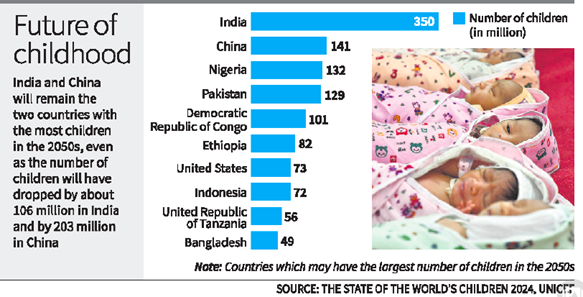TAG: GS-2: INTERNATIONAL RELATIONS & SOCIAL JUSTICE
CONTEXT: The UNICEF State of the World’s Children 2024 report highlights the impact of the climate crisis, demographic shifts and leading technologies on children. It warns that nearly one billion children face climate-related risks, disrupting health, education and livelihoods.
EXPLANATION:
About UNICEF:
-
- The United Nations International Children’s Emergency Fund (UNICEF) was established in 1946, in the aftermath of World War II.
- Mandate: To help children and young people whose lives and futures were at risk – no matter what role their country had played in the war.
- It works in over 190 countries and territories to protect the rights of every child.
- It is headquartered in New York City.
- UNICEF’s work is funded entirely through the voluntary support of millions of people around the world and our partners in government, civil society and the private sector.
- Awards: It has received the Nobel Peace Prize in 1965, the Indira Gandhi Prize in 1989, and the Princess of Asturias Award in 2006.
- It publishes important Reports: The State of the World’s Children, The State of the World’s Children reports.
- Global Initiatives:
- In 2012, UNICEF worked with Save the Children and The United Nations Global Compact to develop the Children’s Rights and Business Principles, and now these guidelines form the basis of UNICEF’s advice to companies.
- UNICEF’s Data Must Speak Initiative (DMS) helps countries unlock existing data to expand access to education and improve learning for all.
Key information from these reports 2024:
-
- Demographic Shifts: Global child population stabilizes at 2.3 billion by 2050, with Africa hosting the highest proportion.
- Climate and Environment: Over 1 billion children live in high-risk countries; exposure to hazards like floods, droughts, and heatwaves is expected to rise sharply.
- Frontier Technologies: Emerging technologies like AI and renewable energy offer transformative potential but must be governed responsibly to ensure equitable access and safety.
- Education: By 2050, 95.7% of children are projected to complete primary education, with significant improvements in gender equality in education globally.
Unprecedented Planetary Crisis for Children
-
- Nearly one billion children, or half the global child population, live in countries facing high risks of climate and environmental hazards.
- The report highlights the triple impact of demographic shifts, climate crises, and frontier technologies on children by 2050.
Climate and Environmental Risks
-
- Children face climate destabilisation, biodiversity collapse, and pollution threats, creating a hazardous and unpredictable environment.
- Children’s developing bodies are uniquely susceptible to pollution and extreme weather impacts, leading to lifelong health issues.

Health and Well-being Threats
-
- Air pollution significantly affects children’s respiratory health and development.
- Rising temperatures increase the spread of diseases like malaria, dengue, and Zika.
- Floods contaminate water supplies, causing waterborne diseases, a major killer of children under five.
- Extreme weather disrupts food production, increasing risks of food insecurity and malnutrition.
Education and Displacement
-
- Since 2022, 400 million students have faced school closures due to extreme weather, violating child rights and stifling economic growth.
- Climate-related disasters displace children, causing trauma, helplessness, and anxiety.
Demographic Shifts
-
- By 2050, the child population will stabilise at 2.3 billion, with growth concentrated in South Asia and Africa, regions already vulnerable to climate risks and poor digital infrastructure.
Frontier Technologies
-
- Technologies like AI, renewable energy, and vaccine breakthroughs offer opportunities to improve childhood but pose risks like digital exclusion and online abuse.
- While 95% of high-income populations are online, only 26% in low-income countries have Internet access, deepening inequalities.
Source:
Spread the Word
